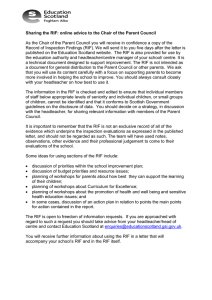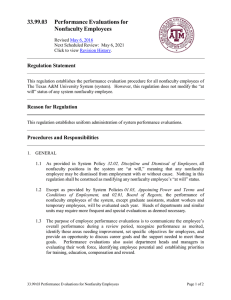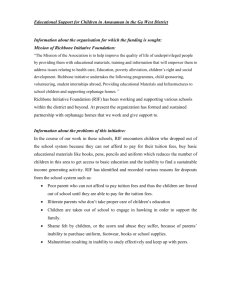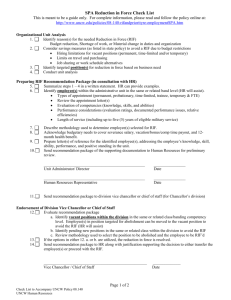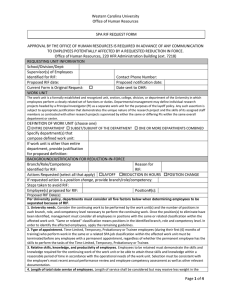33.99.15 Reduction in Force for Nonfaculty Employees
advertisement
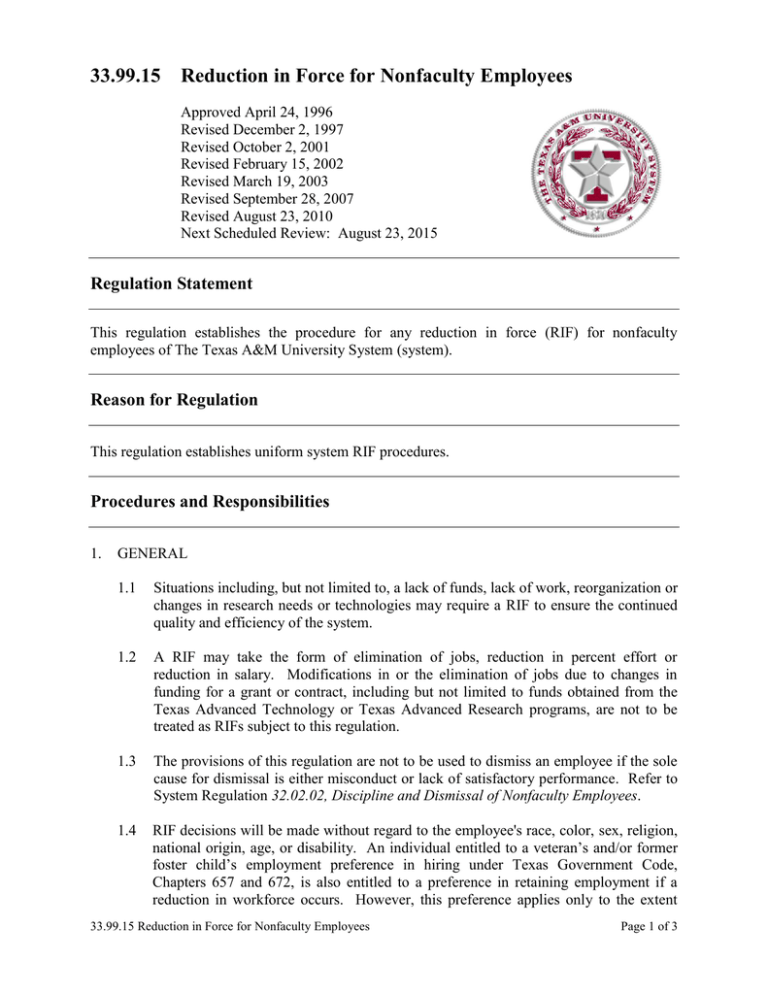
33.99.15 Reduction in Force for Nonfaculty Employees Approved April 24, 1996 Revised December 2, 1997 Revised October 2, 2001 Revised February 15, 2002 Revised March 19, 2003 Revised September 28, 2007 Revised August 23, 2010 Next Scheduled Review: August 23, 2015 Regulation Statement This regulation establishes the procedure for any reduction in force (RIF) for nonfaculty employees of The Texas A&M University System (system). Reason for Regulation This regulation establishes uniform system RIF procedures. Procedures and Responsibilities 1. GENERAL 1.1 Situations including, but not limited to, a lack of funds, lack of work, reorganization or changes in research needs or technologies may require a RIF to ensure the continued quality and efficiency of the system. 1.2 A RIF may take the form of elimination of jobs, reduction in percent effort or reduction in salary. Modifications in or the elimination of jobs due to changes in funding for a grant or contract, including but not limited to funds obtained from the Texas Advanced Technology or Texas Advanced Research programs, are not to be treated as RIFs subject to this regulation. 1.3 The provisions of this regulation are not to be used to dismiss an employee if the sole cause for dismissal is either misconduct or lack of satisfactory performance. Refer to System Regulation 32.02.02, Discipline and Dismissal of Nonfaculty Employees. 1.4 RIF decisions will be made without regard to the employee's race, color, sex, religion, national origin, age, or disability. An individual entitled to a veteran’s and/or former foster child’s employment preference in hiring under Texas Government Code, Chapters 657 and 672, is also entitled to a preference in retaining employment if a reduction in workforce occurs. However, this preference applies only to the extent 33.99.15 Reduction in Force for Nonfaculty Employees Page 1 of 3 that a reduction in workforce involves other employees of a similar type or classification. 2. PROCEDURES 2.1 2.2 3. The chief executive officer (CEO) will determine when a RIF is needed. When such a determination has been made, the following steps will be taken to implement the decision. 2.1.1 An analysis will be performed to determine in which areas, activities, programs, or organizations reductions must be effected. If an entire activity is to be eliminated, steps described in Sections 2.1.2 and 2.1.3 are not applicable. 2.1.2 Within the affected area, the job functions that will need to be performed after the reductions will be identified. 2.1.3 Present employees will be carefully evaluated as to their qualifications and ability to perform the job functions determined in Section 2.1.2. The evaluation of a present employee’s qualifications and ability to perform the job functions could include, for example, factors such as total relevant experience including specialized training, previous performance evaluations including recognition and disciplinary history, and length of service within the system. 2.1.4 After the job functions and the individual employees have been evaluated, the determination of which employees will be subject to the RIF will be made. The documentation used in the evaluation process, along with the explanation, will be sent through appropriate administrative channels to the CEO or designee. If the CEO or designee concurs with the recommendation, the department head or equivalent administrative head will notify affected employee(s) of the RIF decision. Advance notice, while permissible, is not required. If advance notice is provided, the employee may be placed on suspension with pay until the RIF effective date. Any suspension with pay must be submitted to the CEO or designee for approval. A leave of absence will not be granted in lieu of dismissal. PLACEMENT EFFORTS If advance notice is provided, employees designated for dismissal will be given reasonable time off to interview for other jobs prior to the RIF effective date. Every reasonable effort will be made by human resources offices to place dismissed employees in comparable positions for which they are qualified. An employee who refuses to accept a comparable job may forfeit certain rights to unemployment compensation benefits. 4. APPEAL 33.99.15 Reduction in Force for Nonfaculty Employees Page 2 of 3 An employee who receives written notice of a RIF may appeal, as applicable, in accordance with System Regulation 32.01.02, Complaint and Appeal Process for Nonfaculty Employees or System Regulation 08.01.01, Civil Rights Compliance, except that the appeal must be filed within five (5) business days of receiving written notice of the RIF. 5. EFFECT OF RIF ON BENEFITS See System Policy Series 31. Compensation and Benefits, for the effect of a RIF dismissal on compensation, leave and benefits. Related Statutes, Policies, or Requirements Tex. Gov’t Code, Ch. 657 Tex. Gov’t Code, Ch. 672 System Regulation 08.01.01, Civil Rights Compliance System Regulation 32.01.02, Complaint and Appeal Process for Nonfaculty Employees System Policy 32.02, Discipline and Dismissal of Employees System Regulation 32.02.02, Discipline and Dismissal of Nonfaculty Employees Member Rule Requirements A rule is not required to supplement this regulation. Contact Office System Human Resources Office (979) 458-6169 33.99.15 Reduction in Force for Nonfaculty Employees Page 3 of 3
